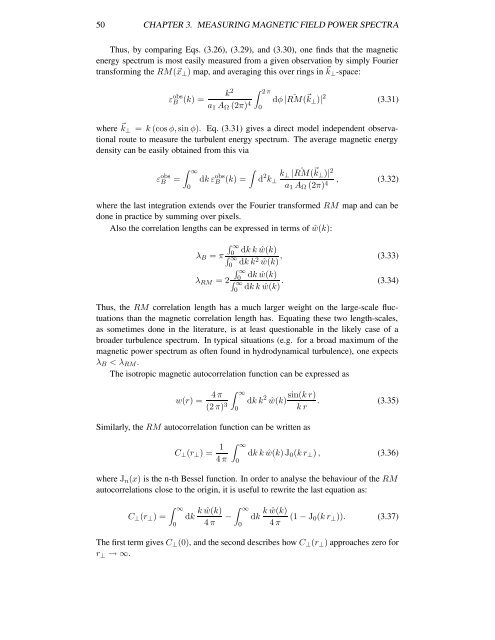Investigations of Faraday Rotation Maps of Extended Radio Sources ...
Investigations of Faraday Rotation Maps of Extended Radio Sources ...
Investigations of Faraday Rotation Maps of Extended Radio Sources ...
Create successful ePaper yourself
Turn your PDF publications into a flip-book with our unique Google optimized e-Paper software.
50 CHAPTER 3. MEASURING MAGNETIC FIELD POWER SPECTRA<br />
Thus, by comparing Eqs. (3.26), (3.29), and (3.30), one finds that the magnetic<br />
energy spectrum is most easily measured from a given observation by simply Fourier<br />
transforming the RM(⃗x ⊥ ) map, and averaging this over rings in ⃗ k ⊥ -space:<br />
ε obs<br />
B (k) =<br />
k 2<br />
a 1 A Ω (2π) 4 ∫ 2 π<br />
0<br />
dφ | ˆ RM( ⃗ k ⊥ )| 2 (3.31)<br />
where ⃗ k ⊥ = k (cos φ, sin φ). Eq. (3.31) gives a direct model independent observational<br />
route to measure the turbulent energy spectrum. The average magnetic energy<br />
density can be easily obtained from this via<br />
ε obs<br />
B<br />
= ∫ ∞<br />
0<br />
∫<br />
dk ε obs<br />
B (k) =<br />
d 2 k ⊥ | RM( ˆ<br />
k ⃗ k ⊥ )| 2<br />
⊥<br />
a 1 A Ω (2π) 4 , (3.32)<br />
where the last integration extends over the Fourier transformed RM map and can be<br />
done in practice by summing over pixels.<br />
Also the correlation lengths can be expressed in terms <strong>of</strong> ŵ(k):<br />
∫ ∞<br />
0<br />
dk k ŵ(k)<br />
λ B = π ∫ ∞<br />
0<br />
dk k 2 ŵ(k) , (3.33)<br />
∫ ∞<br />
0<br />
dk ŵ(k)<br />
λ RM = 2∫ ∞<br />
0<br />
dk k ŵ(k) . (3.34)<br />
Thus, the RM correlation length has a much larger weight on the large-scale fluctuations<br />
than the magnetic correlation length has. Equating these two length-scales,<br />
as sometimes done in the literature, is at least questionable in the likely case <strong>of</strong> a<br />
broader turbulence spectrum. In typical situations (e.g. for a broad maximum <strong>of</strong> the<br />
magnetic power spectrum as <strong>of</strong>ten found in hydrodynamical turbulence), one expects<br />
λ B < λ RM .<br />
The isotropic magnetic autocorrelation function can be expressed as<br />
w(r) =<br />
4 π ∫ ∞<br />
(2 π) 3 dk k 2 sin(k r)<br />
ŵ(k) . (3.35)<br />
k r<br />
0<br />
Similarly, the RM autocorrelation function can be written as<br />
C ⊥ (r ⊥ ) = 1<br />
4 π<br />
∫ ∞<br />
0<br />
dk k ŵ(k) J 0 (k r ⊥ ) , (3.36)<br />
where J n (x) is the n-th Bessel function. In order to analyse the behaviour <strong>of</strong> the RM<br />
autocorrelations close to the origin, it is useful to rewrite the last equation as:<br />
C ⊥ (r ⊥ ) =<br />
∫ ∞<br />
0<br />
dk k ŵ(k) ∫ ∞<br />
4 π −<br />
0<br />
dk k ŵ(k)<br />
4 π (1 − J 0(k r ⊥ )). (3.37)<br />
The first term gives C ⊥ (0), and the second describes how C ⊥ (r ⊥ ) approaches zero for<br />
r ⊥ → ∞.
















